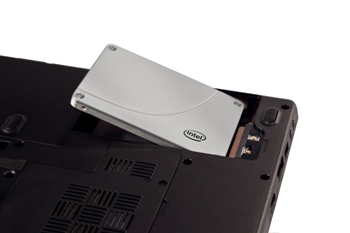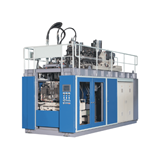Intel has announced its third generation of solid-state drives (SSDs) that offer higher memory capacities at lower prices than predecessors. The devices are based on NAND flash memory fabricated using the company’s 25-nm semiconductor fabrication technology.
Semiconductor manufacturers attempt to pack more transistors onto their chips by continually improving the process technology so that smaller features can be etched onto the silicon wafer. Chips with smaller transistors are cheaper, operate faster, use less power and run cooler than less densely packed devices.
"Intel designed new quality and reliability features into our SSDs to take advantage of the latest 25-nm silicon, so we could deliver cost advantages to our customers," Pete Hazen, Director of Marketing for the Intel Non-Volatile Memory (NVM) Solutions Group, said.
Intel says the Solid-State Drive 320 will come in 40, 80, 120, 160 and new higher capacity 300 and 600 GByte versions. The SSD uses the 3 Gbit/s SATA II interface and can produce up to 39,500 input/output operations per second (IOPS) random reads and 23,000 IOPS random writes on its highest-capacity drives.
Intel also claims it has more than doubled sequential write speeds from its second generation to 220 MBytes/s sequential writes while maintaining read throughputs at up to 270 MBytes/s sequential reads. The company says the greater bandwidth improves a user’s multitasking capabilities.
The conventional hard disk’s moving parts are its Achilles heel. The number 1 cause of failure of hard disks is mechanical failure. SSDs address this at a stroke because they have no moving parts. In addition, because there is no disk to "spin-up", SSDs start and read data more quickly than hard disks.
However, because SSDs are based on NAND flash memory, write times are comparatively slow, so it takes longer to save data. Worse still, these types of disks feature a finite number of write cycles compared to hard disks’ unlimited write cycles. And SSD capacities have lagged behind those of hard disks.
But the biggest disadvantage has been cost. Consequently, despite their reliability advantages, the uptake of SSDs has been limited to premium portable computers such as Apple’s MacBook Air.
Semiconductor manufacturers attempt to pack more transistors onto their chips by continually improving the process technology so that smaller features can be etched onto the silicon wafer. Chips with smaller transistors are cheaper, operate faster, use less power and run cooler than less densely packed devices.
"Intel designed new quality and reliability features into our SSDs to take advantage of the latest 25-nm silicon, so we could deliver cost advantages to our customers," Pete Hazen, Director of Marketing for the Intel Non-Volatile Memory (NVM) Solutions Group, said.
Intel says the Solid-State Drive 320 will come in 40, 80, 120, 160 and new higher capacity 300 and 600 GByte versions. The SSD uses the 3 Gbit/s SATA II interface and can produce up to 39,500 input/output operations per second (IOPS) random reads and 23,000 IOPS random writes on its highest-capacity drives.
Intel also claims it has more than doubled sequential write speeds from its second generation to 220 MBytes/s sequential writes while maintaining read throughputs at up to 270 MBytes/s sequential reads. The company says the greater bandwidth improves a user’s multitasking capabilities.
The conventional hard disk’s moving parts are its Achilles heel. The number 1 cause of failure of hard disks is mechanical failure. SSDs address this at a stroke because they have no moving parts. In addition, because there is no disk to "spin-up", SSDs start and read data more quickly than hard disks.
However, because SSDs are based on NAND flash memory, write times are comparatively slow, so it takes longer to save data. Worse still, these types of disks feature a finite number of write cycles compared to hard disks’ unlimited write cycles. And SSD capacities have lagged behind those of hard disks.
But the biggest disadvantage has been cost. Consequently, despite their reliability advantages, the uptake of SSDs has been limited to premium portable computers such as Apple’s MacBook Air.
Walter Breunig, a Director of Dedicated Systems Australia, a supplier of real time and embedded computing products, says that any price reduction in the cost of SSDs will improve market penetration in Australia.
"For industrial computing applications in particular, SSDs are a good solution because they have no moving parts, are shock and vibration resistant, and can withstand higher temperatures than hard disks," Breunig explained.
"But the downside has always been price."
According to Breunig, SSDs started out about ten times as expensive as conventional hard disks of the same capacity, but have now come down to about three times as much.
"Some of our customers compromise by using cheaper CompactFlash drives of up to 16 GBytes as the mass storage on their embedded computers," Breunig said.
"But if these Intel devices are less expensive than current SSDs, I believe those customers will change over and boost the market share for SSDs above the 10 per cent we currently see."
According to Breunig, SSDs started out about ten times as expensive as conventional hard disks of the same capacity, but have now come down to about three times as much.
"Some of our customers compromise by using cheaper CompactFlash drives of up to 16 GBytes as the mass storage on their embedded computers," Breunig said.
"But if these Intel devices are less expensive than current SSDs, I believe those customers will change over and boost the market share for SSDs above the 10 per cent we currently see."



